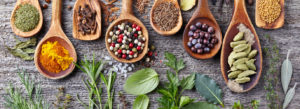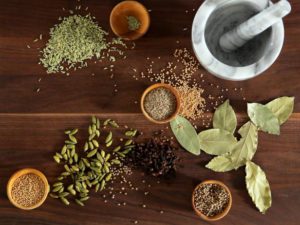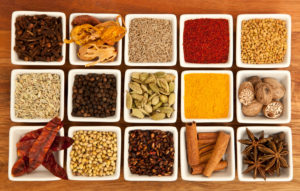Guide To Using Spices
What are Spices?
Spices are the yummy part of a plant that make food taste so good. Spices come from the aromatic parts of tropical plants to include berries, bark, roots and seeds. They also come from dried seeds or fruit of temperate plants. This guide to using spices can be a handy tool the next time you’re in a recipe slump.
Herbs and spices are necessary in every healthy pantry.
They help you add tons of flavor without adding a lot of salt and fat. How many times have you bought fresh herbs only to watch them turn brown in your fridge? Some spices can be a bit pricey, but with these tips, you can make delicious dishes without breaking the bank.
Spices come from all over the world. Spices native to the Asian tropical areas are: cinnamon, cloves, nutmeg, ginger, and pepper. Native to the Mediterranean are the popular seed spices: coriander, fennel, fenugreek, mustard, poppy. Chilies, vanilla and allspice are a few of the spices native to parts of the Caribbean and Central America.
Why Use Spices?

Spice mixtures are popular in that they complement each other. They make your mouth water by both their aroma, which hits you first, and then their taste. Usually, dry spices are added at the start of a dish, while sauteing aromatic vegetables such as onion, celery, pepper to bring out their essential oils. Fresh herbs are added at the end of a dish before serving to keep the fresh taste and brighten the dish.
How To Use Spices
Complex flavors can be created by using mixtures of spices that complement each other. Some spices are used for their taste while others are used for their aroma. The stage at which spices are added to a dish can make a big difference. Typically, they will impart flavor if added at the beginning of the cooking process, but if they are added at the end it is their aromas that will be most noticeable.
One common mistake a lot of people make is to add dry spices near the end of cooking a soup or stew and they don’t have the time to develop and mix into the flavors. It will make the dish taste uncooked. Add them at the beginning, with the sauteed veggies or into the stock as they need the time for the flavors to develop fully. This is because the aroma and flavor of spices come from essential oils. They kind of go dormant sitting in a jar, and you need to wake them up!
Ways to release those essential oils from whole spices:
Grinding: Toast the spices in a dry frying pan over medium low heat, stir and keep a close eye on them as they burn easily. When they start to pop and get light brown and you can smell them, they are done. Best to pour them onto a plate to cool as they will keep browning in a hot skillet. When cool grind them in a coffee grinder (use only a grinder dedicated to spices), or a spice grinder.
Grating: Some larger spices, such as nutmeg and cinnamon bark can be grated on a micro plane grater, or very fine grater. The flavor is superior to buying it in a bottle already ground.
Pounding: Pounding is the old school way to make delicious pastes and to grind spices. Use a mortar and pestle to do this method. It takes a lot of elbow grease, but is a great upper body workout!
Cooking: This is mentioned above, adding your toasted and ground spices to your aromatic veges’s before creating your masterpiece soup, stew, stir fry, or casserole.
The essential oils in spices begin to diminish once they are processed. Freshly processed spices are best, but they do keep well for about 6 months. Whole spices keep for a couple years, just avoid storing them in the light. You can always tell if they are fresh by smelling them.
Spices complete your pantry. You can research spices at the link below:

If you have a stocked spice shelf, you can create a dish when the mood strikes you. Or if you find a recipe that looks good, and don’t have the same spices listed, you can Spice It Your Way!
What if your favorite spice? Let me know, I’ll research all you ever wanted to know and what you can do with it and write a post dedicated to that spice, or herb. No spice gets unnoticed! Thanks, Jeanette
